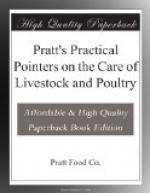The quality of the dry-fed pork has been mentioned. Equally important, from the standpoint of the butcher, is the loss in dressing of hogs. Tests have shown that slop-fed stock loses six to eight pounds more per hundredweight than does the dry-fed.
[Illustration: BERKSHIRE BOAR]
Another big advantage of dry-feeding lies in the fact that large numbers of swine, including those of various ages and sizes, can be safely kept in one herd. The writer has seen over two hundred head of swine, ranging in size from pigs just weaned to 250-pound porkers ready for market, living in peace and contentment in one building, eating and sleeping and sharing the forage pastures together. Of course this means a big saving in buildings and fencing and a great reduction in the amount of necessary labor.
The self-feeder may be used all through the life of the hog, beginning when the pigs are still nursing and continuing until they reach market weight. During all this time the ration should contain Pratts Hog Tonic, the guaranteed hog conditioner, in order that at all times the herd may be maintained in vigorous condition, be kept free from disease, may avoid wasting feed through imperfect or sluggish digestion, may earn for the farmer the maximum amount of profit. We suggest that you make a test of this results-insuring, profit-producing tonic. Watch results. If you are not satisfied the dealer from whom you purchased the goods will refund the full amount you paid for them.
The self-feeding plan of growing hogs gives best results when the animals are given access to growing forage crops. The feeders may be placed under cover out in the fields or kept in the hog house if the latter is reasonably near the pasture lots. An unlimited supply of fresh water must be available at all times because dry-fed stock drinks many times the amount of water that slop-fed hogs do. The reason is plain.
There are many different systems of handling hogs under this plan, varying according to local conditions. We will give in detail the method used most successfully for many years on a Pennsylvania farm which each season markets several hundred hogs of a quality which commands a premium above current quotations.
On this farm, particular attention is paid to keeping the hog houses clean and sanitary, light, sunny and dry. Dampness is always a fertile source of loss. Further, the houses are never crowded. Each animal is given plenty of room.
The brood sows are placed in separate pens at farrowing time and watched carefully when giving birth to the pigs. They are fed a rich slop, a small quantity at first, but in gradually increasing amount until they are receiving enough to insure a big flow of milk.
When the pigs are eight to ten days of age they are permitted to go at will to the self-feeder containing a mixture of ground grains. As a rule, several sows farrow at about the same time and the pens are so arranged that the pigs from several litters may all use one feeder.




